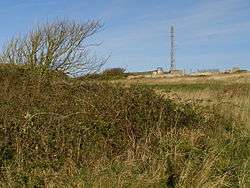RAF Portland
| RAF Portland | |
|---|---|
| Portland, Dorset in England | |
|
The Verne area with the Portland Rotor Radar Station seen in the distance | |
 RAF Portland Shown within Dorset | |
| Coordinates | 50°33′32″N 002°25′53″W / 50.55889°N 2.43139°WCoordinates: 50°33′32″N 002°25′53″W / 50.55889°N 2.43139°W |
| Type | Royal Air Force station |
| Site information | |
| Owner | Ministry of Defence |
| Operator | Royal Air Force |
| Site history | |
| Built | 1950 |
| In use | 1951-2001 |
| Battles/wars | Cold War |
RAF Portland is a former Royal Air Force radar station on the Isle of Portland, Dorset, England. The station is situated in the Verne area, overlooking East Weares. It is now the site of Fancy's Family Farm.[1] The vast radar installations once on site were set up in the early 1950s as part of Britain's Cold War defences.[1] At 70 feet below ground level the site's bunker was the deepest Rotor underground facility. In 2004, the site became a scheduled monument.[2]
Design
The site comprises an irregular enclosure surrounded by fencing with an entrance and guardhouse on the west side. The main guardroom is a single storey, stone-built structure, resembling a bungalow, which provided access to the bunker. The bunker contained the ROTOR control centre. A large reservoir provided the original water supply for the bunker. The site also contained seven radar towers, now dismantled. The operations block was constructed of reinforced concrete - designed to withstand 2,000 lb bombs.[3]
The bunker still contains much its original air conditioning plant, fans, mains transformer, blast doors, electrical switchgear and rotary converters. There is more equipment than in any other surviving R1 or R2 ROTOR bunker. It is the only rotor bunker to retain its original 'Phase 1' layout with an upper floor gallery overlooking the CFP floor.[4] There is remaining soot from a fire in the 1960s in places. The main operations room is the most damaged with no flooring and a lot of water.[5] Six radar plinths remain intact on the surface together with the emergency exit blockhouse (now sealed), a communications mast and building, gatehouse, kennels, the old USAF compound and a reservoir built in the 1980s to serve the dockyard.[6][7]
History
During World War II, the site was the location of a Chain Home Extra Low (CHEL) radar station.[8] It would be replaced by the Portland Centimetric Early Warning (CEW) Radar Station, which was constructed in 1950-51 by contractor Robert McAlpine. The Portland site was one of eight CEW examples built across the country. The Rotor programme was developed to advance the wartime radar technology in detecting and locating fast-flying jets.[3] The station was equipped with various 'Stage One' radar systems.[6]
After the creation of 'Stage Two' Type 80 Mk1 radar systems, many UK stations were refitted however three sites, including Portland were not remodeled. In 1956 the station was declared non-operational, and at CHEL readiness only. Like many other Rotor stations it had a very short operational life. After closure, the site was taken over by the US Air Force who had a microwave relay station built within the fenced enclosure. The underground bunker, though no longer in use by this time, was damaged by fire in 1969. The 1963 film The Damned used the station as the Edgecliff Military Establishment.[9]
Throughout the 1990s the site was used by the Ministry of Defence as a dog training centre. In October 2001 the MOD sold the site via auction. The lift, surrounding stairs and some flooring was stripped, though most of the work was deemed unnecessary and had cost a total of £30,000.[10]
Current use
After being sold, the site was used as horse stables.[5] In June 2011, Fancy's Family Farm moved there from the village of Southwell. The former USAF building became the farm's main centre of operations.[11]
In recent years the site has been listed on English Heritage's Risk Register, with the condition being described as having "extensive significant problems".[12] In May 2013, an event was set up to allow Sub Brit members to enter the underground bunker of the radar station.[13] The bunker was sealed and alarmed due to copper thefts over previous years.[5]
See also
References
- 1 2 "New Ground and Tillycoombe, Portland, Dorset". Geoffkirby.co.uk. Retrieved 23 June 2013.
- ↑ Historic England. "Details from listed building database (1021302)". National Heritage List for England. Retrieved 10 August 2014.
- 1 2 Historic England. "RAF PORTLAND (1405267)". PastScape. Retrieved 23 June 2013.
- ↑ "Subterranea Britannica: Sites:". Subbrit.org.uk. Retrieved 23 June 2013.
- 1 2 3 "Portland ROTOR Bunker, Dorset - Urban Exploring". Theurbanexplorer.co.uk. Retrieved 23 June 2013.
- 1 2 "Subterranea Britannica: Research Study Group: Sites: Portland". Subbrit.org.uk. Retrieved 23 June 2013.
- ↑ "Portland CEW R1 ROTOR Radar Station ('NIB'): 815 Signals Unit - Slogical Discovery". Discovery.slogical.co.uk. Retrieved 23 June 2013.
- ↑ Historic England. "CHAIN HOME EXTRA LOW STATION K73 (1478294)". PastScape. Retrieved 10 August 2014.
- ↑ https://books.google.co.uk/books?id=JS4zBQAAQBAJ&pg=PA112&lpg=PA112&dq=Edgecliff+Military+Establishment&source=bl&ots=DEezaMIjcd&sig=geJogH1p8yTtf6leZYHzDPXIdz4&hl=en&sa=X&ei=PAFnVZP9KdKIsQTpmYKoCQ&ved=0CCYQ6AEwAQ#v=onepage&q=Edgecliff%20Military%20Establishment&f=false
- ↑ "Portland ROTOR". Bunkertours.co.uk. Retrieved 23 June 2013.
- ↑ "News". Fancys Family Farm. Retrieved 25 June 2013.
- ↑ "English Heritage | English Heritage". Risk.english-heritage.org.uk. Retrieved 10 August 2014.
- ↑ "Subterranea Britannica: Sites:". Subbrit.org.uk. Retrieved 17 June 2013.
